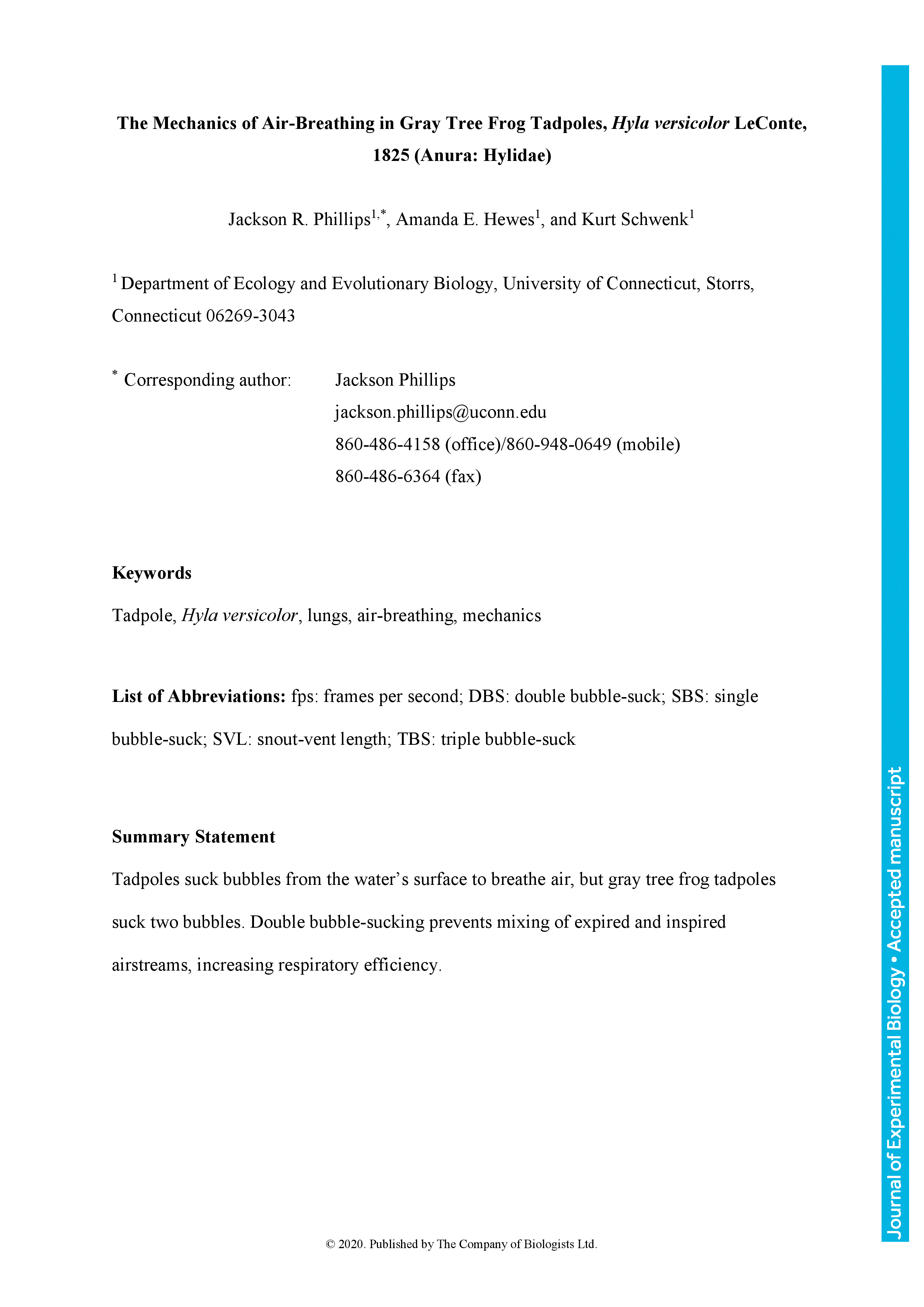We describe air-breathing mechanics in gray tree frog tadpoles (Hyla versicolor). We found that H. versicolor tadpoles breathe by ‘bubble-sucking’, a breathing mode typically employed by tadpoles too small to break the water's surface tension in which a bubble is drawn into the buccal cavity and compressed into the lungs. In most tadpoles, bubble-sucking is replaced by breach-breathing (breaking the surface to access air) at larger body sizes. In contrast, H. versicolor tadpoles bubble-suck throughout the larval period, despite reaching body sizes at which breaching is possible. H. versicolor tadpoles exhibit two bubble-sucking behaviors: ‘single bubble-sucking’, previously described in other tadpole species, is characterized by a single suction event followed by a compression phase to fill the lungs. ‘Double bubble-sucking’ is a novel, apparently derived form of bubble-sucking that adds a second suction event. H. versicolor tadpoles transition from single bubble-sucking to double bubble-sucking at approximately 5.7 mm SVL, which corresponds to a period of rapid lung maturation when they transition from low to high vascularization (6.0 mm SVL). Functional, behavioral, and morphological evidence suggest that double bubble-sucking increases the efficiency of pulmonary gas exchange by separating expired, deoxygenated air from freshly inspired air to prevent mixing. H. versicolor and possibly other hylid tadpoles, may have specialized for bubble-sucking in order to take advantage of this increased efficiency. Single- and double bubble-sucking represent two- and four-stroke ventilation systems, which we discuss in the context of other anamniote air-breathing mechanisms.
The mechanics of air-breathing in gray tree frog tadpoles, Hyla versicolor LeConte, 1825 (Anura: Hylidae)
Currently Viewing Accepted Manuscript - Newer Version Available
Jackson R. Phillips, Amanda E. Hewes, Kurt Schwenk; The mechanics of air-breathing in gray tree frog tadpoles, Hyla versicolor LeConte, 1825 (Anura: Hylidae). J Exp Biol 2020; jeb.219311. doi: https://doi.org/10.1242/jeb.219311
Download citation file:
Advertisement
2023 JEB Outstanding Paper Prize shortlist and winner

The JEB Editors are delighted to announce the shortlisted authors for the 2023 JEB Outstanding Paper Prize. Read the winning paper - Tiny spies: mosquito antennae are sensitive sensors for eavesdropping on frog calls - by Hoover Pantoja-Sanchez and Brian Leavell from Ximena Bernal's lab at Purdue University, USA.
JEB Science Communication Workshop for ECRs

If you’re an early-career researcher interested in science communication and are attending the SEB Annual Conference in Prague this summer, come a day early and join the JEB Editors at a sci comm workshop to learn the key writing skills needed to promote your research to a broad audience beyond your peers (1 July at 14.30-17.30). Places are limited to 24 attendees, and applicants should apply through the SEB registration page by 30 April 2024.
Bridging the gap between controlled conditions and natural habitats in understanding behaviour

Novel technologies enable behavioural experiments with non-model species, in naturalistic habitats and with underexplored behaviours. In their Commentary, Scholz and colleagues discuss how to obtain a deeper understanding of the natural ecology and lifestyle of study animals.
Beluga metabolic measures could help save species

To help save animals from extinction, it’s important to understand what each species needs to survive. This led Jason John et al. to measure the metabolic rates of captive belugas to develop a ‘fish calculator’ showing that the whales need to eat ~23 salmon per day.
ECR Workshop on Positive Peer Review

Are you an ECR looking for tips on how to write concise, astute and useful manuscript reviews? If so, join the JEB Editors at a 2-hour JEB-sponsored Workshop on Positive Peer Review at the Canadian Society of Zoologists annual meeting in Moncton on 9 May 2024 at 13.00-15.00. There are 25 spaces for ECRs and selection is first come, first serve. To sign up, check the ECR Workshop box when you register for the CSZ meeting.



